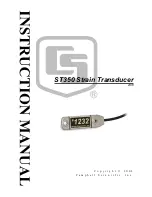
05-2806A01, Rev. L
MDS iNET Series Reference Manual
49
2.6
Configuring the Serial Ports
2.6.1 Overview
The transceiver includes an embedded serial device server that provides transparent encapsulation over IP.
In this capacity, it acts as a gateway between serial and IP remote devices. Two common scenarios are PC
applications using IP to talk to remote devices, and serial PC applications talking to remote serial devices
over an IP network.
Essentially the same data services are available for both serial ports:
COM1
and
COM2
. Note that the trans-
ceiver’s
COM1
port is DCE and
COM2
is DTE. Therefore, if the RTU to be connected is also DTE, then a
null-modem cable will need to be used when connecting to
COM2
.
NOTE:
In the discussion that follows,
COM1
and
COM2
will be treated alike unless noted.
Com1 Port–Dual Purpose Capability
The COM1 port is used as a local console connection point and to pass serial data with an external device.
Setting the
COM1
port status to
Enable
prevents access to the Management System (MS) through this port.
However, the MS can still be accessed via the LAN port using Telnet or a web browser.
To restore the COM1 port to support Management System services, connect a terminal to the port, select
the proper baud rate (19,200 is default), and enter an escape sequence (
+++
) to reset it to the console mode.
TCP vs. UDP
Both types of IP services are used by the transceiver embedded serial device server—TCP and UDP. TCP
provides a connection-oriented link with end-to-end acknowledgment of data, but with some added over-
head. UDP provides a connectionless best-effort delivery service with no acknowledgment.
Most polled protocols will be best served by UDP service as the protocol itself has built-in error recovery
mechanisms. UDP provides the needed multidrop operation by means of multicast addressing.
On the other hand, TCP services are best suited for applications that do not have a recovery mechanism
(error-correction) and must have the guaranteed delivery that TCP provides despite the extra overhead. The
IP-to-Serial example shows how to do this. (See “Configuring for DF1/EIP” on Page 57.)
Serial Encapsulation
Transparent encapsulation, or IP tunneling, provides a mechanism to encapsulate serial data into an IP enve-
lope. Basically, all the bytes received through the serial port are put into the data portion of a TCP or UDP
packet (TCP or UDP are user configurable options). In the same manner, all data bytes received in a TCP
or UDP packet are output through the serial port.
When data is received by the radio through the serial port it is buffered until the packet is received com-
pletely. There are two events that signal an end-of-packet to the radio: a period of time since the last byte
was received, or a number of bytes that exceed the buffer size. Both of these triggers are user configurable.
One radio can perform serial data encapsulation (IP-to-Serial) and talk to a PC. Two radios (or one radio
and a terminal server) can be used together to provide a serial-to-serial channel.
TCP Client vs. TCP Server
A TCP session has a server side and a client side. You can configure the transceiver to act as a server, a
client, or both.
TCP servers listen and wait for requests from remote TCP clients to establish a session. A TCP client is a
program running on a device other than the TCP server. Alternately, TCP clients actively attempt to estab-
lish a connection with a TCP server. In the case of the transceiver, this happens whenever data is received
on the serial port.
Summary of Contents for MDS iNET Series
Page 12: ...x MDS iNET Series Reference Manual 05 2806A01 Rev L...
Page 159: ...05 2806A01 Rev L MDS iNET Series Reference Manual 147 Figure A 22 EDS Wizard Completion Screen...
Page 165: ...05 2806A01 Rev L MDS iNET Series Reference Manual 153 NOTES...
Page 166: ...154 MDS iNET Series Reference Manual 05 2806A01 Rev L NOTES...
















































